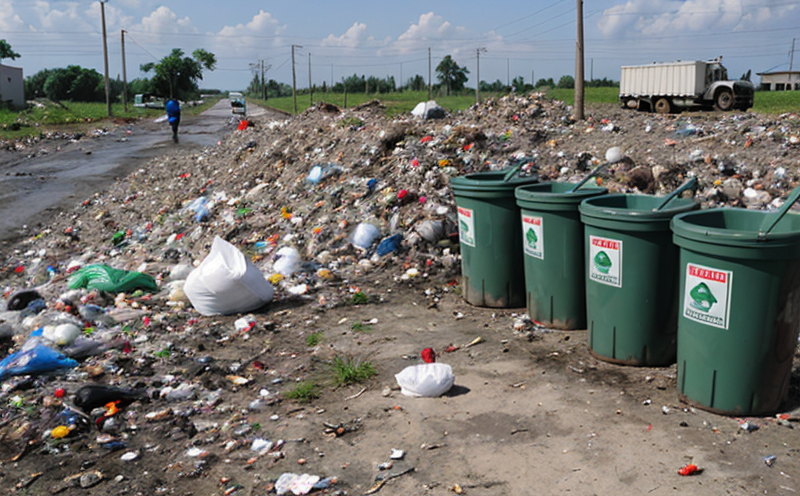EN 12457-1 Leaching Compliance Test for Solid Waste
The EN 12457-1 standard specifies the procedure for determining the leachability of solid waste. This standardized test is essential in ensuring that solid waste materials do not release harmful substances into the environment when disposed of, thus protecting public health and the environment.
The test measures the amount of potentially hazardous contaminants—such as heavy metals—that can be released from a waste sample during a simulated leaching process. Compliance with this regulation is crucial for manufacturers, waste management companies, and environmental agencies to ensure regulatory compliance and safe disposal practices.
To perform the EN 12457-1 test, solid waste samples are placed in a leachate solution under controlled conditions that mimic real-world scenarios of landfill environments. The leaching process is designed to simulate the breakdown processes that occur over time. After several days or weeks, depending on the specific duration specified by regulatory requirements, the leachate is analyzed for its concentrations of regulated contaminants.
The testing procedure typically involves detailed sample preparation and handling to ensure accurate results. Samples are carefully weighed, mixed with the leaching solution, incubated in controlled conditions, and then filtered or centrifuged to separate the liquid phase from the solid residue. The resulting leachate is analyzed using various analytical techniques such as atomic absorption spectrophotometry (AAS) for heavy metals.
The results of this test are critical for compliance with environmental regulations. Regulatory bodies may require specific concentrations of contaminants in waste materials, and non-compliance can lead to penalties or the imposition of additional remediation measures. This test is also important for R&D purposes, where understanding leachate composition helps refine waste management practices.
For accurate results, it’s essential to use appropriate laboratory equipment such as precision balances, pH meters, and filtration systems. Compliance officers should familiarize themselves with the exact parameters required by their local or international standards. The test also requires strict adherence to safety protocols due to the handling of potentially hazardous materials.
| Application | Description |
|---|---|
| Municipal Waste Management | Testing waste from municipal landfills ensures that harmful substances are not released into the environment during disposal. |
| Industrial Waste Handling | Monitoring industrial waste leachates helps prevent contamination of soil and groundwater, ensuring compliance with environmental laws. |
The EN 12457-1 test is a critical component in the broader context of solid waste management. By understanding how different types of waste behave under specific conditions, stakeholders can develop more effective disposal strategies that minimize environmental impact.
Why It Matters
The EN 12457-1 Leaching Compliance Test is critical for several reasons:
To ensure compliance with international and local regulations regarding the safe handling of solid waste materials.
To protect public health by preventing the release of harmful contaminants into the environment.
To support responsible environmental stewardship in both industrial and municipal settings.
To facilitate effective decision-making for waste management practices, ensuring that disposal methods do not cause long-term harm to ecosystems.
The test results provide valuable insights into the potential risks associated with various types of waste materials. This information is crucial for developing more sustainable and environmentally friendly waste management strategies.
For compliance officers, understanding these tests can help in identifying areas where improvements are needed and implementing corrective actions. For R&D engineers, the data from this test can guide innovation in waste treatment technologies.
Industry Applications
| Industry Sector | Application Details |
|---|---|
| Municipal Waste Management | This sector uses the test to monitor waste from municipal landfills and ensure compliance with environmental laws. |
| Construction & Demolition Waste | The test helps in assessing the potential for harmful materials like asbestos or lead to be released into the environment during disposal. |
The EN 12457-1 Leaching Compliance Test is widely used across various industries, particularly those dealing with solid waste. It ensures that waste management practices are safe and sustainable, reducing the risk of environmental contamination and public health hazards.
Construction & Demolition Waste: This sector specifically uses this test to evaluate the leachability of materials like concrete or asphalt, which can contain hazardous substances.
Mining and Metals: The test helps in assessing the environmental impact of mining waste, ensuring that harmful metals do not contaminate surrounding ecosystems.
By conducting this test, industries can make informed decisions about waste disposal methods and materials selection to minimize their ecological footprint.
Quality and Reliability Assurance
The EN 12457-1 Leaching Compliance Test is crucial for maintaining quality and reliability in solid waste management practices. The test ensures that all stakeholders adhere to the highest standards of environmental protection, which is essential for meeting regulatory requirements.
Consistency: Ensures consistent results across different samples and laboratories by using standardized procedures.
Accuracy: Provides accurate data on leachate composition, enabling informed decision-making regarding waste disposal methods.
Reliability: Guarantees reliable compliance with environmental regulations, reducing the risk of legal penalties or operational disruptions.
The test also supports continuous improvement in waste management practices. By regularly monitoring waste leachability, industries can identify potential issues early and implement corrective actions to prevent contamination.
Quality managers play a key role in ensuring that laboratories conducting these tests follow best practices. This includes using calibrated equipment, maintaining proper sample handling procedures, and adhering to strict quality control measures.





